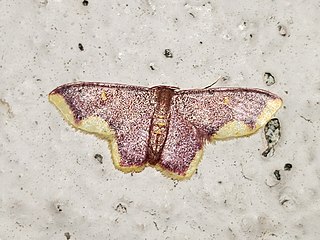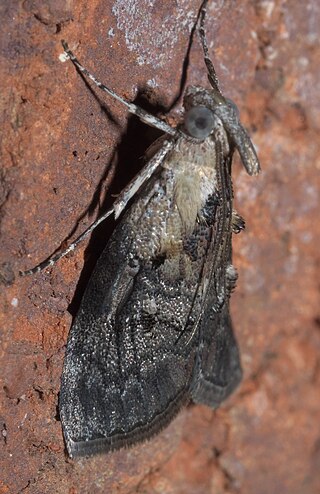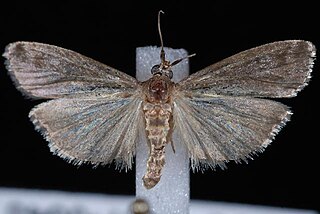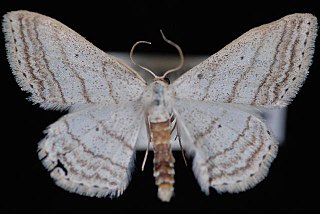
Ammophila arenaria is a species of grass in the family Poaceae. It is known by the common names marram grass and European beachgrass. It is one of two species of the genus Ammophila. It is native to the coastlines of Europe and North Africa where it grows in the sands of beach dunes. It is a perennial grass forming stiff, hardy clumps of erect stems up to 1.2 metres (3.9 ft) in height. It grows from a network of thick rhizomes which give it a sturdy anchor in its sand substrate and allow it to spread upward as sand accumulates. These rhizomes can grow laterally by 2 metres in six months. One clump can produce 100 new shoots annually.

Digrammia was a genus of moths in the family Geometridae erected by Carl Freiherr von Gumppenberg in 1887. It is now often considered a synonym of Semiothisa.

Lophosis is a monotypic geometrid moth genus. Its only species, Lophosis labeculata, the stained lophosis, is found in North America. Both the genus and species were first described by George Duryea Hulst, the genus in 1896 and the species in 1887.

Tetracis is a genus of moths in the family Geometridae erected by Achille Guenée in 1858.
Euxoa aurulenta, the dune cutworm, is a moth of the family Noctuidae. The species was first described by Smith in 1888. It is found in North America from Ontario west to Alberta and Washington, south to Illinois, Nebraska, Colorado and Arizona.

The Phycitinae are a subfamily of snout moths. Even though the Pyralidae subfamilies are all quite diverse, Phycitinae stand out even by standards of their family: with over 600 genera considered valid and more than 4000 species placed here at present, they unite up more than three-quarters of living snout moth diversity. Together with the closely related Epipaschiinae, they are apparently the most advanced lineage of snout moths.

Homoeosoma is a genus of moths of the family Pyralidae.

Pococera is a genus of snout moths in the subfamily Epipaschiinae, found mainly in North and Central America. It was described by Philipp Christoph Zeller in 1848.
Coenochroa is a genus of snout moths, family Pyralidae. It was described by Émile Louis Ragonot in 1887. Species are known Eurasia, North Africa, and the Americas.
Coenochroa californiella is a species of snout moth in the genus Coenochroa. It was described by Émile Louis Ragonot in 1887. It is found in North America from British Columbia to California, Kansas, Texas, Mexico and Panama in Central America.
Coenochroa bipunctella, the sand dune panic grass moth, is a species of snout moth in the genus Coenochroa. It was described by William Barnes and James Halliday McDunnough in 1913, and is known from the United States, including Florida, Arizona and Maryland.
Coenochroa chilensis is a species of snout moth, family Pyralidae. It was described by Jay C. Shaffer in 1992. It is known from Ñuble Province, Chile.
Erelieva quantulella is a species of snout moth. It was described by George Duryea Hulst in 1887. It is found in the south-eastern United States.
Homosassa ella is a species of snout moth. It was described by George Duryea Hulst in 1887. It is found in North America, including Florida, Oklahoma, South Carolina and West Virginia.
Olybria aliculella is a species of snout moth, and the type species in the genus Olybria. It was described by George Duryea Hulst in 1887 and is known from Arizona, New Mexico and Texas.

Oreana is a monotypic snout moth genus described by George Duryea Hulst in 1887. Its only species, Oreana unicolorella, described by Hulst one year earlier, is known from most of North America.

Scopula ancellata, the angled wave moth or pointed-winged wave, is a moth of the family Geometridae. It was described by George Duryea Hulst in 1887. It is found in North America from Quebec west to the Northwest Territories and British Columbia and south to Michigan, Indiana and Arizona. The habitat consists of mixed wood and coniferous forests.
Crambus trichusalis is a moth in the family Crambidae. It was described by George Duryea Hulst in 1886. It is found in North America, where it has been recorded from Alberta, Saskatchewan, Montana, North Dakota and South Dakota. The habitat consists of grasslands.
Caberini is a tribe of geometrid moths in the family Geometridae. There are at least 50 described species in Caberini.

Peoria is a genus of moths of the snout moth family (Pyralidae). The genus was erected by Émile Louis Ragonot in 1887.









